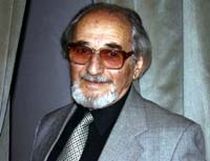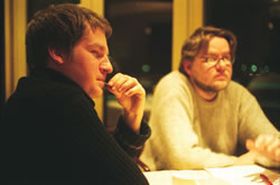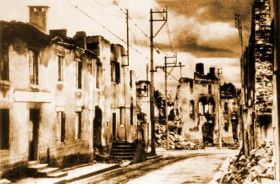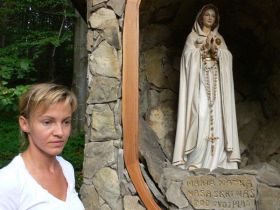DEN DOKUMENTARISKE FORTÆLLING, SAMLEDE BLOGINDLÆG / THE DOCUMENTARY NARRATIVE, COLLECTED BLOGPOSTS
Skabelsen af dokumentarfilmen, sammenholdt med dokumentarprogrammet og fiktionsfilmen / English version after the Danish
AF MIKAEL OPSTRUP
Teksten her er kommet til på min insisterende opfordring. Jeg har længe vidst, at Opstrup skrev på en lang og udførlig tekst om dokumentarfilmens dramaturgi. For nogen tid siden viste han mig en kort og meget stram version. Vi blev enige om at forsøge at give den poetikkens klassiske form. Og det har Opstrup så gjort. Dette er resultatet. (Allan Berg Nielsen, 2008)
DEN DOKUMENTARISKE FORTÆLLING
1. Fiktionsfilmen er defineret af historien. Et handlingsforløb som nedfældes i manuskriptet og siden omsættes til film. Instruktørens arbejdsproces er lineær og fiktionsfilmen er dramaturgisk friktionsfri. Der er kun et handlingsforløb. Fiktionsinstruktørens bestræbelse er fortælling.
2. Dokumentarprogrammet er defineret af emnet. En begivenhedsrække, som journalisten gengiver så objektivt som muligt. Selv om objektivitet er en umulighed og skabelsen af programmet dermed modsætningsfyldt, er journalistens bestræbelse entydig og vejen mod det uopnåelige er lineær, som i fiktionsfilmen. Der er kun et handlingsforløb. Journalistens bestræbelse er gengivelse.
3. Dokumentarfilmen er defineret af både et begivenhedsforløb og en fortælling. Begivenhedsforløbet finder sted i den virkelighed dokumentarfilmen beskriver. Fortællingen er instruktørens genfortælling af begivenhedsforløbet. Der er to handlingsforløb og kernen i dokumentarfilmens dramaturgi er modsætningen mellem de to handlingsforløb, det faktuelle og det narrative. Dokumentarinstruktørens bestræbelse er genfortælling.
4. Både fiktionsfilmen og dokumentarprogrammet består ideelt set af to skarpt opdelte forløb: i fiktionsfilmen at skrive et manuskript og derpå omsætte dette til film; i dokumentarprogrammet at indsamle fakta og derpå at ordne disse begivenheder i et program; dokumentarfilmens forløb består ideelt set af en uendelig vekselvirkning mellem at skabe fortællingen, optage begivenhedsforløbet og ændre fortællingen.
5. Således har dokumentarfilmen noget til fælles med både dokumentarprogrammet og fiktionsfilmen. De to dokumentargenrer har den antagonistiske modsætning mellem virkelighed og formidling til fælles; men hvor journalistens bestræbelse vil være at minimere modsætningen, vil dokumentarinstruktørens være at uddybe den.De to filmgenrer har fortællingen til fælles, da der ingen dramaturgisk forskel er på fiktionsfilmen og dokumentarfilmen; men hvor fiktionsinstruktøren selv skaber fortællingens enkeltelementer – scenerne – må dokumentarinstruktøren beslutte, om den ene eller den anden begivenhed er bærer af enkeltscenen i den dokumentariske fortælling.
6. Dokumentarfilmens modsætning mellem det faktuelle og det narrative er antagonistisk i arbejdsmæssig henseende men komplementær i kunstnerisk forstand. Antagonisme er det forhold, at to ting er uforenelige modsætninger. At to modsætninger udelukker hinanden. Komplementaritet er det forhold, at to sider af en sag foruden at udelukke hinanden også kompletterer hinanden. At to modsætninger er hinandens forudsætninger.
7. Skabelsen af en dokumentarfilm er en antagonistisk proces. For instruktøren personligt fordi fortolkningen af virkeligheden kun bliver interessant, hvis den er resultat af en stræben mod objektivitet – velvidende at det er i fortolkningens møde med gengivelsen at dokumentarfilmen bliver til kunst. Og arbejdsmæssigt fordi vi skal formulere en fortælling på et tidspunkt, hvor vi endnu ikke kender det begivenhedsforløb, fortællingen gengiver. Det kan ikke lade sig gøre. Men det lader sig gøre. Det sker ved at transformere den antagonistiske modsætning til en komplementær.
8. Det betyder, at man hele tiden skal ændre fortællingen efter udviklingen i virkelighedsforløbet. Det vanskelige ligger i at hengive sig til den absolutte stræben, som er forudsætningen for en vellykket og forløst fortælling, velvidende at virkeligheden hele tiden vil ændre fortællingen. Konstant at stræbe mod at strukturere en virkelighedsfremstilling, som må korrigeres af virkeligheden. At kombinere absolut åbenhed med absolut beslutsomhed. At stræbe fuldt og helt mod det uopnåelige. Ja netop at finde styrken til at stræbe, fordi målet for denne stræben, er uopnåeligt.
9. Dette forhold er kernen i arbejdet med den dokumentariske fortælling. At erkende nødvendigheden af at transformere den antagonistiske modsætning mellem virkelighed og fortælling til en kreativ komplementær modsætning, er en bevidsthedsmæssig forudsætning for at skabe dokumentarisk filmkunst. At skabe det fuldendte ved at stræbe mod det umulige.
10. Dokumentarfilmen forløses kunstnerisk, når kun det ene lag – virkeligheden – er synligt som kontinuerlig fortælling. Når genfortællingen ikke fungerer harmonisk, dvs. hvis enkeltelementerne fra virkelighedsforløbet ikke er fuldstændigt sammenfaldende med scenerne i fortællingen, åbenbares dette andet lag – fortællingen – som et postulat. Derved ændres det virkelige begivenhedsforløb fra at udgøre fortællingens elementer til at blive en ny og selvstændig fortælling. Filmen får dermed to uafhængige narrative forløb, hvorved værket falder fra hinanden. Men når instruktørens fortælling går op i en højere enhed med virkeligheden, ophører den med at være til stede i tid og rum og findes blot som dramaturgisk klarhed.
11. Evnen til at arbejde kreativt forløsende med uforenelige modsætninger er en central evne hos dokumentarfilm instruktøren. (Blogpost 9. oktober 2008)
THE DOCUMENTARY NARRATIVE
The creation of the documentary – compared to the documentary programme and the fiction film
By Mikael Opstrup
1. Fiction is defined by the story. A course of events that is written down in the script and then converted into a film. The directors work process is linear and the fiction film is from a dramaturgic point of view frictionless. Only one course of events exists. The fiction director’s endeavour is storytelling.
2. The documentary programme is defined by the subject. A course of events that the journalist reproduces as objectively as possible. All though objectivity is an impossibility and the creation of the programme thereby antagonistic, the journalist’s effort is unambiguous and the road towards the unattainable is linear as in fiction. Only one course of events exists. The journalist’s endeavour is reproduction.
3. The documentary film is defined by both a course of events and storytelling. The course of events takes place in the reality the documentary describes. The story is the director’s retelling of the event. There are two courses of events and the core of the documentary’s dramaturgy is the contradiction between the two courses of events, the factual and the narrative. The documentary director’s endeavour is retelling.
4. Both the fiction film and the documentary programme exist ideally of two clear-cut developments: In fiction to write a script and there after to transform it into film; in the documentary programme to collect facts and there after to put the events in order in a programme. The documentary film exists ideally of en endless interaction between the creation of the story, recording of the events and changing the story.
5. Hence the documentary has things in common with both the documentary programme and the fiction film. The two documentary genres have the antagonistic contradiction between reality and presentation in common; but where as the journalist’s endeavour is to minimize the contradiction the documentary director’s endeavour is to maximize it. The two film genres has the storytelling in common; but where as the fiction director creates the story’s components – the scenes – himself, the documentary director has to decide if the one or the other event is the bearer of a scene in the documentary story.
6. The documentary film’s contradiction between the factual and the narrative is antagonistic in work-related respect but complementary in artistic respect. Antagonism is the condition that two sides of an issue are inconsistent. That two contradictions exclude each other. Complementarity is the condition that two sides of an issue besides excluding one another at the same time complement one another. That two contradictions presuppose one another.
7. The creation of a documentary is an antagonistic process. On two levels. Personally for the director because the interpretation of reality only becomes interesting if it is the result of a strive for objectivity – well aware that it is in the interpretation’s encounter with the reproduction the documentary film becomes art. Work related because we have to put forward a story at a time where we do not know the course of events, the story reproduces. This is not possible. But it is done. Done by transforming the antagonistic contradiction into a complementary paradox.
8. This means to constantly modify the narrative one has created because the perception of reality constantly changes the story. The difficulty being the devotedness towards absolute aspiration, which is the essential prerequisite for a successful and released story, well aware that reality constantly will change the story. Constantly striving to organise a presentation of reality that must be corrected by reality. Combining absolute openness with absolute resolve. Striving body and soul to achieve the unattainable. Actually finding the strength to strive because the very goal one is striving to attain is unattainable.
9. This condition is the essence of working with the documentary story. To realise the necessity of transforming the antagonistic contradiction between reality and storytelling into a creative complementary paradox is a conscious prerequisite for the creation of documentary film art. The creation of the complete by striving towards the unattainable.
10. The documentary film is released artistically, when only one layer – reality – is visible as a continual narrative. When the retelling is not harmonious, i.e. if the single elements from the course of events are not completely convergent with the single scenes in the story, this second layer – the narrative – is revealed as a postulate. Thus the actual sequence of events is reversed from representing the elements of the narrative to becoming a new and autonomous narrative. Thus the film gets two independent courses, by which the work falls apart. But when the director’s work comes together with reality it ceases its presence in time and space and exists only as dramatic clarity.
11. The ability to work creatively releasing with inconsistent contradictions is a key ability of the documentary film director. (Blogpost 9. oktober 2008)
REMARK TO IB BONDEBJERG
Thanks for Ib Bondebjergs comment on my ‘Den dokumentariske fortælling’ which I guess can be translated to ‘The documentary narrative’. However it misses my approach to the matter.
First of all my view is the creators point of view, it’s an attempt to clarify the elements the documentary creator works with. It is not a genre classification. Secondly I deal with the narrative structure – not the format or the aesthetic solutions.
Making a documentary, the director needs to know whether the story is constructed by the theme or the narrative.The first one being the journalistic driven documentary program and the second the narrative driven documentary film.
By journalistic driven I mean that the next possible scene in the film is decided by the theme, the purpose being to deepen and improve the knowledge of the theme. In the narrative driven documentary the next scene is defined by the story you’re telling. Let me give an example: in ‘The Monastery’ it is just as impossible for Pernille Rose Grønkjær to include an informative scene about the roots and history of monasteries in Russia and Denmark as it is for Alistair Maclean to include a scene that describes the political role of Greece in WWII in ‘The guns of Navarone’.
The creation of this narrative documentary is what my poetic ‘The documentary narrative’ is about. A genre that is defined by the complementary conflict between re-telling reality and reconstructing it artistically.That – for the creator – contains an insoluble contradiction and it is the successful solution of the insolubleness that is the artistic core of documentary film making. And that fascinates me so much.
This point may not be so interesting from the point of view of the product – the documentary film that is finished. But from the creating point of view it is the key question.10 years as tutor at pitching workshops around Europe; 4 years as production adviser at The Danish Film Institute and 15 years as documentary producer has confronted me with an endless number of projects where the major struggle for the creators has been to find the creative narrative that is included in the actual reality the film apparently is about.This is the core of the director’s work when developing the project at the early stage and with trying to explain it to film consultants and commissioning editors.
On top of this comes HOW you choose to tell your story once you have found out WHAT the story is: do you include dramatizations; interviews; a strong narrator; poetic montage etc. But that’s another story… (Blogpost 19. november 2008)
http://www.filmkommentaren.dk/blog/blogpost/508/ (Ib Bondebjerg’s post)
PHOTO: MIKAEL OPSTRUP, Head of Studies, EDN (Baltic Sea Docs 2016)
Mikael Opstrup has been a dedicated documentary filmmaker since he made his first S-8mm documentary, in 1977, now hidden for the public in his cellar. Most of the 80’s Mikael worked with distribution and theatrical release of documentaries.
In 1988 he attended script writing at the DanishFilmSchool. Worked as a freelance production manager up through the 90’s and organized the film festival ‘Films from the South’ from 1995 – 1998. Made a desk-cross-over from 1998-2002, where Mikael worked as production adviser at The Danish Film Institute. Mikael started his exclusive career as tutor at EDN workshops in the same period. Attended EAVE 1998/99. 2002-2008 was a co-owner and producer at Final Cut Productions in Copenhagen. Has produced a number of international documentaries, among them The German Secret, Joris Evens Competition at IDFA 2005. An EDN Executive Committee Member from 2005 – 09, the last year as Chairman. Now serves at Head of Studies at EDN.
Mikael Opstrup, Head of Studies, EDN, Phone: +45 3313 1122. Mobile: +45 2964 8976, Fax: +45 3313 1144, Skype: mikael.opstrup, www.edn.network











